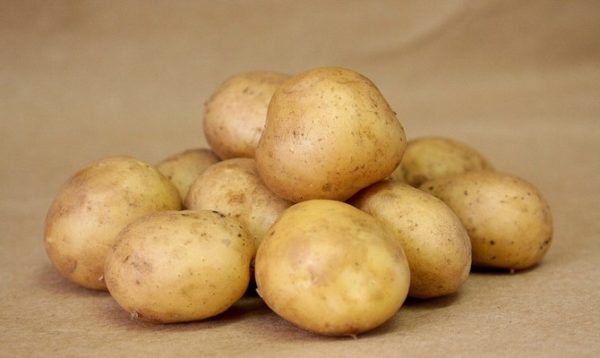
Description of the “Luck” potato variety, its photos and reviews of gardeners will help everyone understand the features of cultivating this type of root crops. Russian breeders are positioning the subspecies as an excellent seed to obtain a high-quality crop at the end of June.The photo clearly shows even oblong tubers of the Udacha variety with a thin skin and a flat surface, which significantly reduces the amount of waste during processing. In the description and user reviews on the network, a high keeping quality of the crop was noted during prolonged storage in an ordinary cellar or basement.
Content
Description and characteristics of the “Good luck” potato variety
The tubers have a smooth peel, over time, when stored, it can turn from light beige to dark brown. Eyes are weakly expressed, which does not affect yield. On the cut, the flesh has a white tint in its raw form, and when cooking it becomes cream yellow. Medium-sized potatoes are rarely heavier than 200 g, but the small size of the tubers is offset by their large number under the bush.
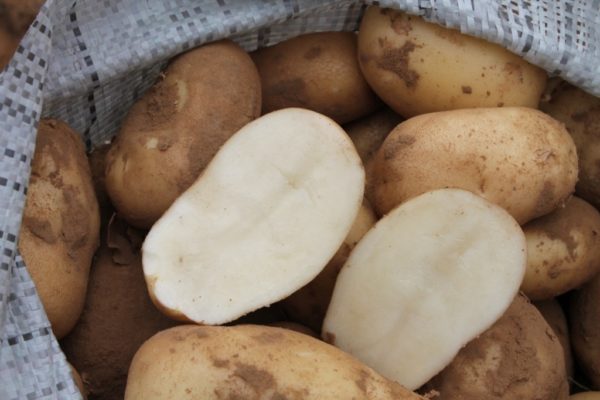
The bush grows medium size, well leafy, with tops of dark green color. Blooms amicably, with snow-white rosettes.
Grade Advantages
In most areas, the variety shows good results on sandy and dense soils, more dependent on climatic conditions than on agricultural cultivation. Not afraid of low temperatures, both during the growing season and during storage. It tolerates viral infections and rhizoctaniasis; it has relatively moderate resistance to the following ailments:
- late blight;
- wrinkled mosaic;
- blackleg;
- wet rot;
- common scab.
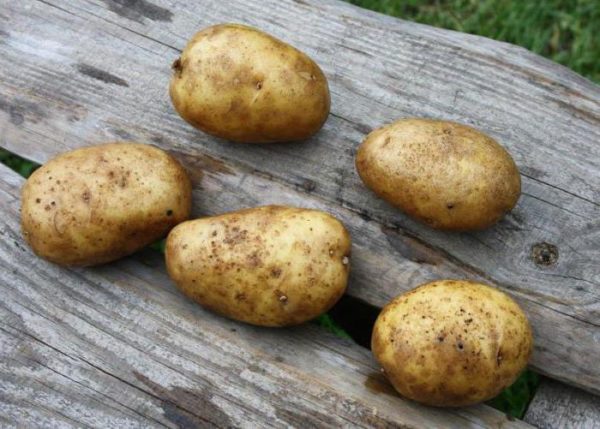
The first crop can be obtained already on the 45th day after germination. Since the tubers tolerate mechanical damage well, you can slightly dig up the bush and choose large potatoes, prolonging the yield of the variety for several months. Subject to the rules of growing and caring for plants, from each bush you can get at least 1 kg of high-quality products.
Rules for growing potatoes "Luck"
The best predecessors of the variety are:
- rye;
- peas;
- beans;
- beet.
Attention: you can not plant potatoes in areas that in the previous season were occupied with pepper, tomatoes, carrots, cucumbers.
Soil preparation
After harvesting at the end of the season, dig the beds cleaned from debris on a bayonet shovel. Simultaneously with loosening the soil, the following fertilizers should be applied per 1 sq. M:
- 30 g of superphosphates;
- 10 kg of ripened compost;
- 15 g of potassium salt.
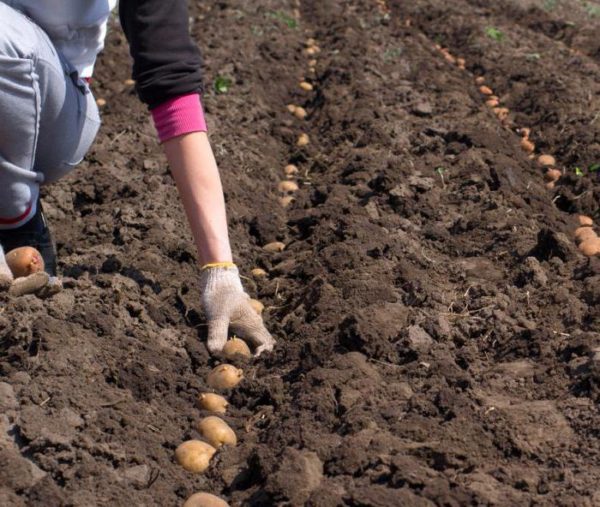
Re-dig half a spring in the spring by adding the following components per 1 sq. M:
- 1 tbsp. wood ash; 2
- Art. l nitrofoski or nitroammofoski.
If the main site is peat soil, during spring work it is necessary to add 1 bucket of humus, compost or river sand. For clay soils, the surface of the bed should be mixed with peat or humus in the same amount per 1 sq. Km. mIn areas with sandy soils, it is necessary to weight the garden with clay or peat, using 1 bucket of additives for this.
The right choice of tubers
Gardeners begin to buy potatoes for planting in mid-April. In this case, you should look at the quality certificate of the goods, which in essence is a passport of potatoes. There, all data of planting material must be entered without fail:
- crop year, grade;
- reproduction;
- landing place;
- farm address;
- external characteristics and purpose of tubers.
The best is the elite and superelite - this means that for another 5 years the Luck potato will delight with a high and high-quality crop.
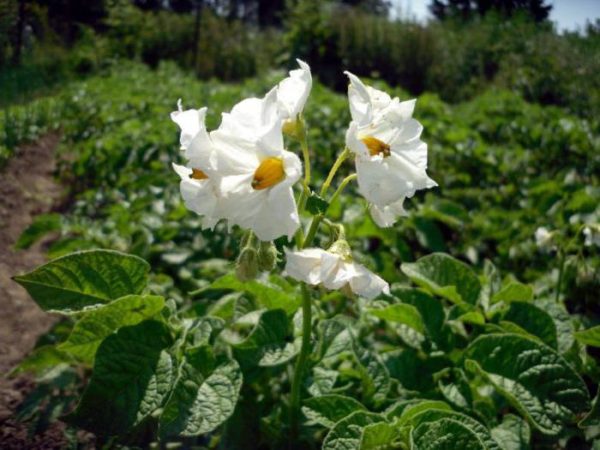
All tubers should be the size of a chicken egg, with a smooth and even skin. This means that such planting material was stored in the right conditions, will not fail during planting and will provide high-quality offspring. You should not buy sprouted potatoes for planting - many varieties, especially early ones, do not tolerate breaking off sprouts.
Tuber germination
Tubers of the required size should be selected and brought into a room with an air temperature not lower than +16 degrees and not higher than +18. The variety is characterized by a large number of large fruits. Therefore, in the crop year, planting material of the desired size is difficult to find. A large potato cut into several parts will perfectly cope with the task. In this case, you need to ensure that on each piece there are 2-3 eyes.
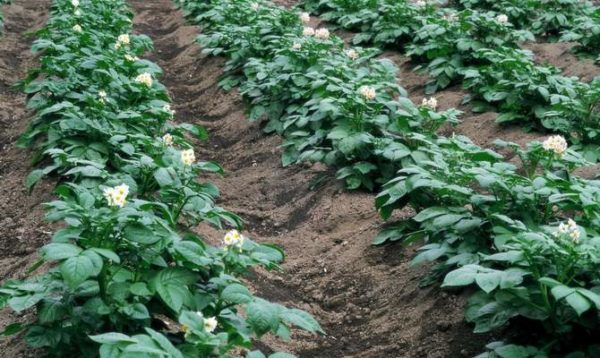
Powder the slices with wood ash and lay the resulting material on racks in one layer. A prerequisite is good illumination of the room for germination - under the sun's rays in the tubers solanine accumulates. This is a natural plant protection against fungi and pests.
Experts recommend accelerating germination by placing planting material in a liquid substrate - this will accelerate the growth of the root system simultaneously with the appearance of sprouts.
Planting potatoes
The scheme for laying planting material in the ground at the Luck potato is standard - at least 20 cm between bushes and 30-40 cm between rows. If potatoes are chopped, holes or furrows should not be deeper than 6 cm, if whole potatoes should not be deeper than 10 cm.
When planting, it is recommended to make a handful of wood ash and ripened compost for each future bush. It is not worth increasing the quantity of fertilizers at once - it will not bring a good crop. It is better to combine additional feeding with hilling.
Ripening time
Producers, when characterizing the “Luck” potato, declare the opportunity to try the fruits of the new crop already 45 days after germination. Independently check the readiness of new potatoes for use should be a week or two after the start of flowering.
It is necessary to carefully dig up the bush and check the size of one or two tubers - if they have grown to the size of a chicken egg, "Luck" is ready for use. Marketable potatoes of this variety will have after a complete lodging of the yellowed bush. It is about 60-80 days after planting.
Rules for the care of potatoes "Luck"
The main agricultural technique in the cultivation of this variety is the timely loosening of the soil and sufficient fertilizing of the plant, depending on the type of soil in the cultivation area. The variety is declared as drought tolerant, so you do not have to water the bed with potatoes. The exception is the long heat, in which the soil under the bushes becomes too hot.
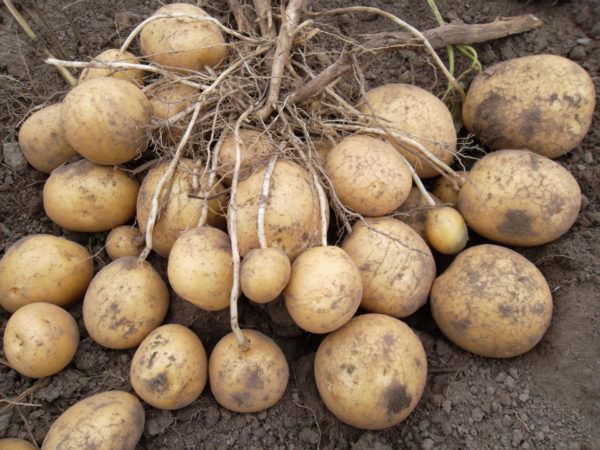
On the eve of spring frosts, the beds with the plant need to be covered with suitable material, or sprinkled with earth as high as possible.
Possible diseases and pests
If the spring and early summers are rainy, you should stock up with contact and systemic insecticides - in wet weather, viral diseases can develop on the potato:
- late blight;
- Alternariosis.
Lamprey gardeners use a mixture of copper sulfate with water or a solution of copper sulfate in addition to chemical means of combating diseases.
The main pest for the Luck potato remains the Colorado potato beetle. Here you can pickle the bushes and collect the beetle and its larvae by hand. Nematodes and wireworms love to enjoy young tubers. In this case, chemicals can not be dispensed with. They must be repaired in the soil before planting tubers and in row-spacing when hilling. Marigolds planted on potato beds are suitable from folk remedies - they perfectly disinfect the soil and scare away most insects with their smell.
Collection and storage
As soon as all the bushes lie down and begin to dry - "Luck" is ready for digging and storage. When sorting, it is important to look at each potato and discard diseased or damaged fruits. Dry the tubers in the shade, with good ventilation. Experts recommend spraying the resulting crop with a solution of copper sulfate in a proportion of 2 g per 10 liters of water - this will disinfect the tubers and keep the crop for longer.
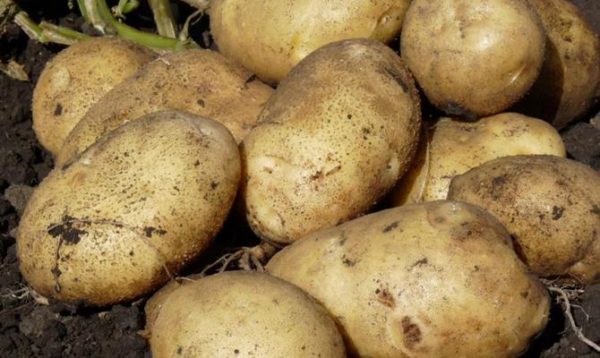
Pour tubers installed in the cellar, tubers with absolutely dry skin. The storage temperature of the crop should not exceed 4 degrees of heat in cold weather. Otherwise, the potatoes will begin to germinate too early, and the sprouts from the cellar have much worse yield indicators than those prepared in the sun.
Reviews
Elena Petrovna:
“I plant the third year“ Luck ”- I really like that the harvest is good and tasty.”
Igor:
“Last year phytophthora killed the whole crop, very sorry. And before that, he removed 11 buckets from 1 bucket of planting material "Good Luck" - there was beauty. "
Vasily Nikolaevich:
“I plant several buckets every year - we eat, practically, until the new harvest. What is remarkable - the longer it lies in the cellar, the tastier it becomes. ”




 Description and description of varieties in Belarus with a photo
Description and description of varieties in Belarus with a photo Do I need to pick flowers from potatoes: why do they do it
Do I need to pick flowers from potatoes: why do they do it When to dig potatoes: timing and availability of new potatoes
When to dig potatoes: timing and availability of new potatoes How to grow a good potato crop: various methods and methods, planting and care
How to grow a good potato crop: various methods and methods, planting and care